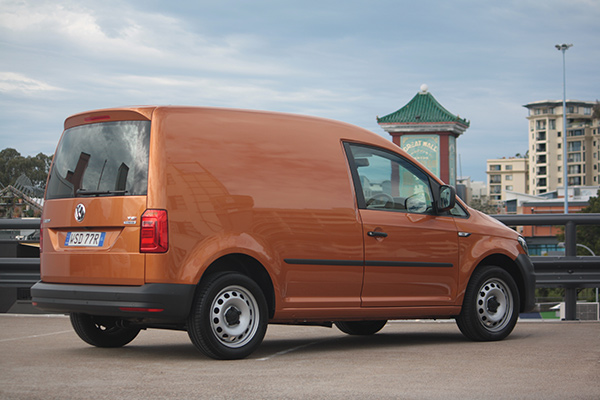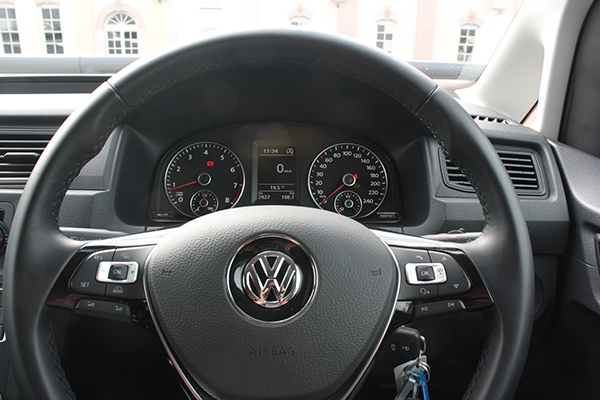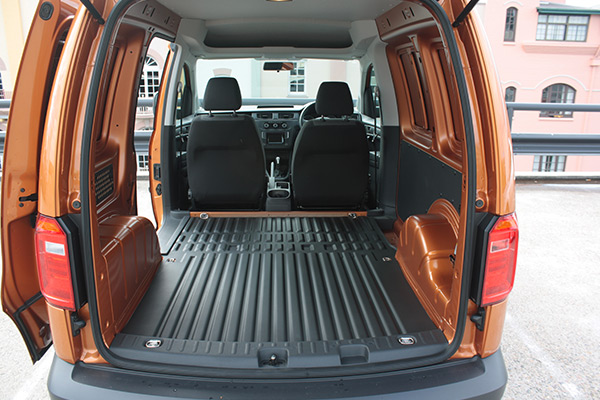A 2016 update of the Volkswagen Caddy saw the departure of diesel and a new platform for the little best-seller
There was a time, many years ago, when all I wanted in life was to paint pictures of naked women and starve in a bohemian garret.
Apparently the best way to do this is to hang around art gallery openings for the free cask wine and talk about art in breathless hushed tones, (this tends to sound like a couple of giggling 5 year-olds trying to blow up a whoopee cushion behind a sofa).
Or alternatively elaborate expansively on the exhibition with a plastic wine glass in hand while trying not to douse other people with lukewarm moselle. As I found, it’s actually possible to do both.
The only bit of that ambition that I had any real success with however, was the starving bit.
One thing I did learn during that period of time though was the concept of negative space.
The artistic idea of negative space is where the space around the object in question is of more interest than the object itself. And that in a nutshell tends to sum up most people’s view of light commercial vans.
I reckon this is a little unfair however as there are some very interesting vans at the lighter end of the spectrum that are worth more than a passing glance.
And the hugely successful Volkswagen Caddy is one of them.
Leaving Volkswagen’s DieselGate behind
Last year’s exercise in emissions embarrassment, otherwise commonly known as ‘DieselGate’, saw the temporary withdrawal of a couple of VW’s diesel plants both globally and in Australia.
However, a new Volkswagen Caddy emerged for 2016 with a new 1.4-litre petrol engine that was not only touted to be cleaner and more fuel efficient than the oil-burners, but also offered more grunt and pulling power.
Emissions hiccups aside, the Caddy continues to dominate the sub 2.5-tonne van market in Australia.
According to Federal Chamber of Automotive Industries (FCAI) VFACTs figures the VW Caddy accounts for over 50 per cent of this segment. Its closest erstwhile competitor, the Renault Kangoo is the next down the tree at over 26 per cent.
The new Caddy uses the same platform as the Volkswagen Beetle, Jetta, and Tiguan and features some new standard and optional anti-crashing devices, brake energy recuperation and as before is available in both short and long wheelbases.
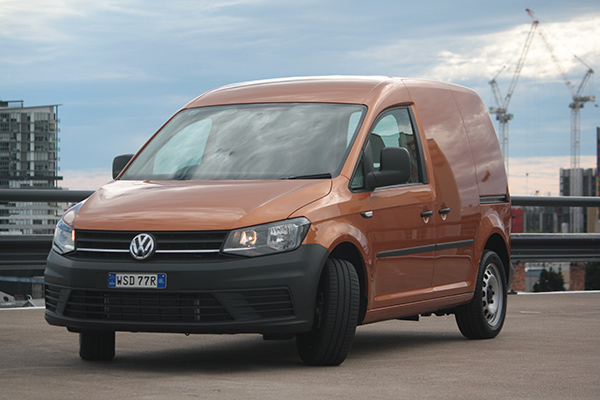
2016 Caddy details
Engine and transmission
As mentioned previously, for the time being the front-wheel-drive Caddy relies solely on a 1.4-litre turbocharged petrol engine for power.
This rather sophisticated little unit puts out quite impressive 92kW and 220Nm. And that twisty force is on tap from 1,500 to 3,500Nm.
A possible down side for commercial buyers is that it needs a diet of Premium Unleaded to keep the home fires burning.
The 1.4 TSI BlueMotion engine also uses engine start/stop to help with fuel economy.
Transmission choice is between a 6-speed manual or the 7-speed self-shifting DSG unit.
The claimed fuel figures for this little panel van are pretty good too. The petrol has a claimed combined fuel consumption figure of 6.0L/100km for the DSG equipped Caddy and 6.2L/100km for the manual versions.
Suspension and load
A double wishbone McPherson strut front end irons out the bumps at the front end and a traditional leaf spring arrangement takes care of the rear.
Steering is an electro-mechanical rack and pinion set up.
Short Wheel Base variants have a payload of up to 773kg, LWB variants are up to 840kg, while LWB crew versions have a max payload of 733kg.
SWB Caddy’s have 3,200 litres of cargo space and LWB versions have 4,200 litres.
LWB Crew versions with fold down second row seat have only slightly less room at 4,130 litres.
For buyers that have a constant load in the back (racking, tools, coffee etc) there’s a reinforced rear suspension option. This is recommended for vans that have a constant load of 150kg (SWB) and 200kg (Maxi).
Clearly this is a way of keeping the ride a bit nicer for empty running yet having the option of a bit of beef in the rear end. And the roof will take 100kg of load if you want to whack some racks on it.
Interior packages
Volkswagen has made the myriad of options a little easier to wade through by grouping them into packages. The Driver Assistance pack is full of safety features including adaptive cruise, forward collision warning, and cornering lights amongst others.
The Interior Comfort pack adds a few creature comforts in the cab and the Appearance pack is just that. There’s also a bunch of window options as well as the choice of 60/40 split barn doors or a lift up tailgate.
And the van itself sits on 16-inch steel or alloy wheels.
Extras
The 2016 Caddy also comes with a portable ashtray as standard equipment.
I don’t know why I feel the need to point this out, but there’s something quite quaint about the fact that Volkswagen list a portable ashtray on the spec sheet as standard equipment.
Some manufacturers dropped ashtrays from their vehicles years ago. Yet someone at VW was charged with creating the perfect portable ashtray.
It’s like finding a perfectly crafted Edison globe hanging in the interior.
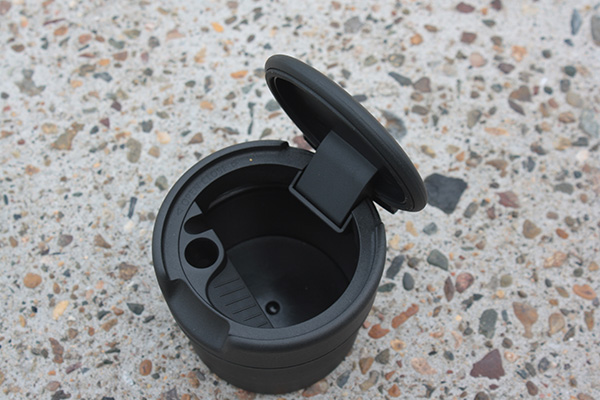
2016 Caddy Test Drive
We spent a bit of time with the Caddy recently to catch up on where the diminutive little hauler was at post diesel.
The last Caddy we’d had the keys for was a 1.6-litre diesel Maxi which proved to be a very nice little jigger to punt around urban and country roads.
This one however was a very orange 1.4-litre short wheelbase variety and was equipped with the 7-speed DSG ‘box.
Cab and controls
The addition of the Interior Comfort pack did take away some of the stern coldness that often seems to be a feature of these little load luggers.
There’s plenty of dark dashboard but this was broken up by the multi-media unit that displays the reverse camera as well.
As much as I hate using car references when talking about vans, the cockpit of the Volkswagen is car-like and comfy.
The analogue instruments are well placed and easy to read. A simple digital menu displays all the usual info from fuel economy to doubling as a digital speedo – something handy in this day and age of robot speed enforcement.
As per previous models, there’s just enough storage for a work day.
The overhead console is an obvious place for throwing paperwork and clipboards – though it may be a bit of a challenge to extract those items after a drive around a few corners.
There are also enough cubby holes to lose pens, phone chargers, lollies, and bottles if needed.
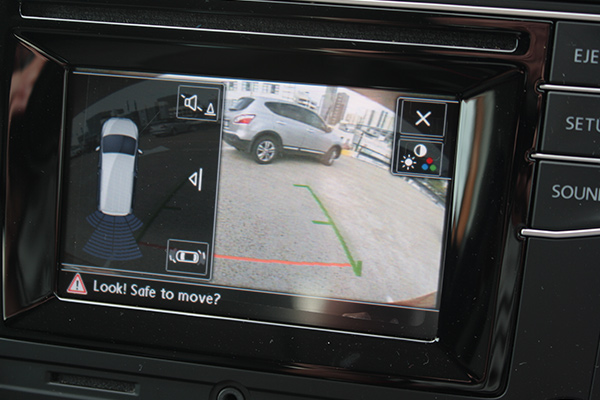
Road performance
With the advent of the new model, the Caddy did cop a new wheelbase.
However, interior dimensions remain unchanged which makes life easier for owners of previous models when it comes to fitting their pre-existing racking, shelving, and equipment.
There’s always going to be a bit of road noise thrumming through the cargo area of a van, though less so in a front-wheel-drive. However, the 1.4 is a willing little unit that seems both happy to rev and lug at the same time.
The car/SUV platform that the Caddy is based on also makes it a very civilised little panel van to punt through city traffic.
Visibility is great and the optional rear view camera and parking sensors are a sensible box to tick for those who tackle the urban hurly burly on a daily basis.
The 1.4 TSI has more than enough grunt to hurtle the Volkswagen Caddy along at a respectable rate of knots with surprisingly little lag off the line.
And even though it has inner city delivery written all over it, the Caddy is a happy highway cruiser that handles in a way that belies its commercial intentions.
I know it’s not cool but in this SUV-riddled world I’m still surprised more people don’t opt for the people mover variants of these things because they are great little units to pilot.
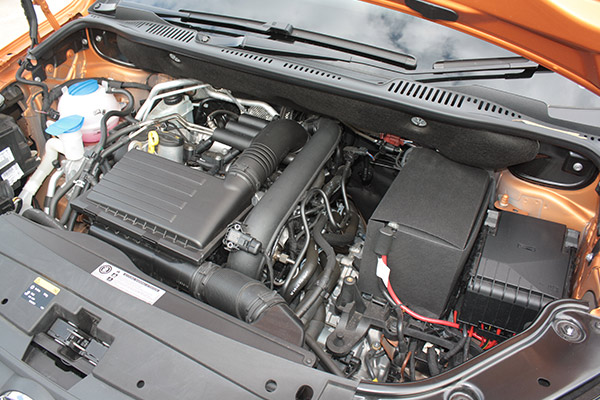
The DSG tranny however doesn’t perform to expectations when negotiating the urban jungle.
As far as robotised manual ‘boxes go the DSG is a good one. However, while clutch engagement from a standstill is good it does have some annoying characteristics.
For example, rolling up to a roundabout looking for a break in the traffic can see some hesitation before the DSG finds the gear it wants and gets power to the ground.
This fumble tends to be exacerbated if you forget to turn the start/stop function off.
By the time the engine fires up and the van is in gear you can lose valuable milliseconds when trying to slot into a busy stream of traffic.
Plus, when taking off when either loaded or empty the Caddy can seem to have trouble deciding how long to hold onto a gear before an upshift.
As previously stated the little petrol engine has quite a bit of oomph for its size, yet in conjunction with the DSG it sometimes takes off like a scalded cat, or bogs down.
Considering how slick most Euro manuals are these days I’d opt for a stick shift.
The Aussie market’s preference for auto’s is a bit of a frustration for many Euro manufacturers.
Much of the buying public doesn’t differentiate between a self-shifting manual like the DSG cog ‘box and a torque converter automatic.
To most they are both ‘autos’ and expectations of performance are the same.
Verdict
But, even with the DSG, the Caddy is a nice drive.
The pint-sized petrol power plant is also a frugal one with VW claiming 6.0l/100km combined for the DSG-equipped Caddy and 6.2l/100km for the manual.
I certainly wasn’t able to exceed those figures during my few days in the little Honey Orange beastie. Maybe I wasn’t trying hard enough.
Even without the traditional diesel, the space occupied by the Caddy isn’t negative at all.
In fact, the future’s looking rather positive for Volkswagen’s baby van.
Specifications: Volkswagen Caddy TSI220 SWB
Engine: 1.4-litre turbocharged direct injection petrol
Power: 92kW@4,800 rpm/ 220Nm@1,500-3,500rpm
Transmission: 7-speed DSG automated or 6-speed manual.
Payload: 773kg
Capacity: 3.2 cubic metres
Price: From $28,990 MRP less on roads for DSG equipped.
Service Intervals: 12 months/15,000 kilometres
Warranty: 3 years unlimited kilometres.















